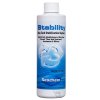Fishless Cycling
- Thread starter zennzzo
- Start date
You are using an out of date browser. It may not display this or other websites correctly.
You should upgrade or use an alternative browser.
You should upgrade or use an alternative browser.
Cane sugar is completly unnessicary the nitrogen fixing bacteria use carbon dioxide as ther carbon source not carbohydrates the only organic waste they need is ammonnia and nitritebrianp;2675455; said:This is actually a very good question, but not with respect to ammonia, per se. Now, I’m confident that the following comments may not be well received by the advocates of fishless cycling, but I think a full body of information is useful. The bacteria that oxidize ammonia and nitrite also require a carbon source for their metabolism and growth, which fishless cycling does not provide. In a mature aquarium, this carbon source is provided by various components of fish waste, bacterial death, etc. FC occurs in a more or less “sterile” environment. In the absence of a carbon source, the growth of bacteria is handicapped. Personally, I like technical intervention and fishless cycling is a useful technique. I have never used it, but have no doubt that it works. However, the limitations I see with fishless cycling are first, it must be performed BEFORE the fish are added. Second, it requires monitoring of the ammonia dosages, nitrite leves, etc., and finally, it is a protracted process, requiring several weeks to come to fruition. On the other hand, if you’re a science geek (like me), you would probably enjoy this process, the recordkeeping, etc. If I didn’t have a viable alternative, I would simply recommend that a carbon source, such as cane sugar be added to this regimen to expedite the establishment of the bacterial lawn. However, based upon personal experience, I believe that there is a much better method of tank cycling available. Specifically, I am referring to Seachem Stability. I realize that with the exception of Biospira, these “bottled bacteria” products have generally perform poorly…if at all. However, Stability employs bacterial “spores”, which is really an inspired approach. I can personally attest to the effectiveness of this product. It’s true, that I did supplement my new 350 with cane sugar, but in my hands, Stability performed flawlessly…with the fish in the tank. The tank was cycled within approx. eight days. I believe that such an approach is much easier to implement that fishless cycling and has the added convenience of being used in situ….in other words, with the fish occupying the tank. In fact, the fish become part of the solution, because not only are they discharging ammonia, but are also producing the organic waste which the bacteria need for metabolism and growth. It is rare to find a product which is so effortless to deploy and yet so effective in performance.
http://en.wikipedia.org/wiki/Nitrosomonas the wiki page on the bacterium that fixes ammonia to nitrite stating how it gets its carbon from cabon dioxide i'd assume the nitrite fixing bacteria use a similar pathway or use teh carbon left behind when these bacteria die
What if my tank has been running for a long time with internal **** pumps, and i finally saved up and bought a tetratech ex1200 external pump.
The cycling thing is only needed for new tanks and new filters right? not old tanks and new filters?
So basically what i'm asking is: When i receive my new pump on monday, will i be able to assemble it, plug it in and that's that?
The cycling thing is only needed for new tanks and new filters right? not old tanks and new filters?
So basically what i'm asking is: When i receive my new pump on monday, will i be able to assemble it, plug it in and that's that?
what do you mean ''internal'' pumps?HrHagel;3465861; said:Anyone?
What type of filtration do you have?
pix would help...
Uhm, i mean those standard little filters that you plug on the inside of the tank.
I have two AM-TOP AT-1000F's running right now, but it's clearly not enough for the current load.
But what i wanna know is, if the cannister filter i bought (Tetra tech ex1200) would have to undergo some sort of cycling before i can plug it to the tank? Or is that only if it's a freshly started tank
I have two AM-TOP AT-1000F's running right now, but it's clearly not enough for the current load.
But what i wanna know is, if the cannister filter i bought (Tetra tech ex1200) would have to undergo some sort of cycling before i can plug it to the tank? Or is that only if it's a freshly started tank
you could also recycle a tank by rinsing out a dirty filter of a develpoed tank. save the dirty water and put the dirty water into the new tank. I've done it on three tanks and it has worked every time with no deaths.
OK so you bought a canister filter and it is brand new...HrHagel;3465920; said:Uhm, i mean those standard little filters that you plug on the inside of the tank.
I have two AM-TOP AT-1000F's running right now, but it's clearly not enough for the current load.
But what i wanna know is, if the cannister filter i bought (Tetra tech ex1200) would have to undergo some sort of cycling before i can plug it to the tank? Or is that only if it's a freshly started tank
Cycling has to do with the filtration, not the tank per se...
the majority of the Beneficial Bacteria is housed IN the filter...
Just do this...
leave the current filters on/in your tank.
AFTER you thoroughly clean all the new parts of the brand new filter
Install the canister on the tank as per the manufacturers instructions.
Get a bottle of SeaChem's "STABILITY"
follow the label EXACTLY and in 7 days time your new filter will be cycled...



